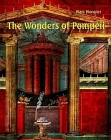
Wonders of Pompeii

Description
Wonders of Pompeii
by
Marc Monnier
A railroad runs from Naples to Pompeii. Are you alone? The trip occupies one hour, and you have just time enough to read what follows, pausing once in a while to glance at Vesuvius and the sea; the clear, bright waters hemmed in by the gentle curve of the promontories; a bluish coast that approaches and becomes green; a green coast that withdraws into the distance and becomes blue; Castellamare looming up, and Naples receding.
Large Print, 15 point font
**************
Excerpts:
All these lines and colors existed too at the time when Pompeii was destroyed: the island of Prochyta, the cities of Baiæ, of Bauli, of Neapolis, and of Surrentum bore the names that they retain. Portici was called Herculaneum; Torre dell'Annunziata was called Oplontes; Castellamare, Stabiæ; Misenum and Minerva designated the two extremities of the gulf. However, Vesuvius was not what it has become; fertile and wooded almost to the summit, covered with orchards and vines, it must have resembled the picturesque heights of Monte San Angelo, toward which we are rolling.
The summit alone, honeycombed with caverns and covered with black stones, betrayed to the learned a volcano "long extinct." It was to blaze out again, however, in a terrible eruption; and, since then, it has constantly flamed and smoked, menacing the ruins it has made and the new cities that brave it, calmly reposing at its feet.
What do you expect to find at Pompeii? At a distance, its antiquity seems enormous, and the word "ruins" awakens colossal conceptions in the excited fancy of the traveller. But, be not self-deceived; that is the first rule in knocking about over the world. Pompeii was a small city of only thirty thousand souls; something like what Geneva was thirty years ago. Like Geneva, too, it was marvellously situated-in the depth of a picturesque valley between mountains shutting in the horizon on one side, at a few steps from the sea and from a streamlet, once a river, which plunges into it-and by its charming site attracted personages of distinction, although it was peopled chiefly with merchants and others in easy circumstances; shrewd, prudent folk, and probably honest and clever enough, as well. The etymologists, after having exhausted, in their lexicons, all the words that chime in sound with Pompeii, have, at length, agreed in deriving the name from a Greek verb which signifies to send, to transport, and hence they conclude that many of the Pompeians were engaged in exportation, or perhaps, were emigrants sent from a distance to form a colony.
Yet these opinions are but conjectures, and it is useless to dwell on them.
Our little city made no great noise in history. Tacitus and Seneca speak of it as celebrated, but the Italians of all periods have been fond of superlatives. You will find some very old buildings in it, proclaiming an ancient origin, and Oscan inscriptions recalling the antique language of the country. When the Samnites invaded the whole of Campania, as though to deliver it over more easily to Rome, they probably occupied Pompeii, which figured in the second Samnite war, B.C. 310, and which, revolting along with the entire valley of the Sarno from Nocera to Stabiæ, repulsed an incursion of the Romans and drove them back to their vessels. The third Samnite war was, as is well known, a bloody vengeance for this, and Pompeii became Roman. Although the yoke of the conquerors was not very heavy-the municipii, retaining their Senate, their magistrates, their comitiæ or councils, and paying a tribute of men only in case of war-the Samnite populations, clinging frantically to the idea of a separate and independent existence, rose twice again in revolt; once just after the battle of Cannæ, when they threw themselves into the arms of Hannibal, and then against Sylla, one hundred and twenty-four years later-facts that prove the tenacity of their resistance.
On both occasions Pompeii was retaken, and the second time partly dismantled and occupied by a detachment of soldiers, who did not long remain there. And thus we have the whole history of this little city. The Romans were fond of living there, and Cicero had a residence in the place, to which he frequently refers in his letters. Augustus sent thither a colony which founded the suburb of Augustus Felix, administered by a mayor. The Emperor Claudius also had a villa at Pompeii, and there lost one of his children, who perished by a singular mishap. The imperial lad was amusing himself, as the Neapolitan boys do to this day, by throwing pears up into the air and catching them in his mouth as they fell. One of the fruits choked him by descending too far into his throat. But the Neapolitan youngsters perform the feat with figs, which render it infinitely less dangerous.
228 pages - 7 x 8½ softcover
ISBN-10: 1610336747
ISBN-13: 9781610336741














